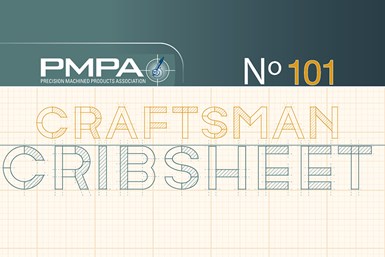Craftsman Cribsheet No. 101: Audit Certifications
Quality documentation can aid in problem-solving, but only if it is complete.

Just because a document claims to be a ‘certification’ doesn’t mean it actually contains the information that you need to have confidence in the material that you buy and then further warrant to your customer.
A situation arose where a PMPA member had secured four different releases of a steel item from a steel service center. The steel from three of the releases performed fine in process. One did not. Material certifications lacked several key facts that could have helped provide an explanation:
- No ASTM specification. Without such a specification, the document isn’t certifying to an agency specification or standard. The document did caption a purchase order, but did the P.O. actually capture all the requirements? The “certification” was actually stating that the results are true and correct copy of records — including chemistry as reported by original (but unknown) supplier.
- Full chemistry reporting only carbon, manganese, phosphorus, sulfur, silicon and lead may seem to cover all chemical elements of interest, as long as the material runs well in process. However, when trying to investigate differences between different heats, the full chemistry could have indicated different origin of the material prior to the processing and purchase by the service center. A difference in copper content or other residual elements (nickel, chrome, molybdenum) could have shown a difference between supplier processes ahead of the service center. This could have also implied other elements that might be different as a result of different process — such as nitrogen — which may have had an effect on the shop’s process.
- No reduction ratios reported. The reduction ratio might have shown us obvious differences between lots indicating process differences/mill supplier differences which could indicate a need to adjust the process. No reduction ratio, no insight as to the possible similarities or differences in the amount of work in process between the different batches of steel provided.
- Unexplained tensile test results. The material for all four releases was ordered to a single specific decimal size, but the tensile properties that were reported under the heading of “Physical” included the following: Release #1, 17/32-78,170 (no mention of units); Release #2, 17/32-71,800; Release #3, ½-70,347; and Release #4, ½-80,000. However, under another field labeled “Other,” the documents reported “Drawn Tensile, PSIs” for release #1 of 1A-99,770, 1B- 99,770; Release #2, 1A- 93,445; Release #3, 81,987; Release #4, 89,300. Difference of tensile properties between the different values from the two reported on each cert ranged from over 30.1% for release #2 tensile to 11.6% in tensile strength for the release in question. That amount of variation generates questions.
- No identification of actual mill source. Traceability is crucial, and often mandated by various Buy American rules from the federal government. No assurance that the material was of domestic origin. The differences in heat number formats did suggest different suppliers — 10 numeric digits with the same first digit for two releases; one nine-digit heat number with first two digits being alpha, remainder numeric for the third; and the final release having a heat number of only nine numeric digits. Likely to have been two — perhaps three — different original hot roll sources.
Have you audited the information that your suppliers are providing to you on their “certifications/test reports?” Just because a document claims to be a ‘certification’ doesn’t mean it actually contains the information that you need to have confidence in the material that you buy and then further warrant to your customer. Audit your “certifications!”
Related Content
A No/Low-Cost Solution to Employee Retention
Studies show a little employee recognition goes a long way. Here are the 5Ws to consider for success.
Read MoreDo You Have a Quoting Process?
The only way to have repeatable results is to have a process.
Read MoreCold-Drawn Steel Barstock: How It Is Manufactured, Benefits to Your Shop
Understanding the benefits provided by cold-drawn steel barstock can help you optimize the work you quote by maximizing benefits to your manufacturing process and customer.
Read MoreKeeping It In The Family — Succession Tips From Those Who Lived It | Part 1
PMPA members share some tips to avoid getting burned when passing the business torch from one family member to another.
Read MoreRead Next
A Tooling Workshop Worth a Visit
Marubeni Citizen-Cincom’s tooling and accessory workshop offers a chance to learn more about ancillary devices that can boost machining efficiency and capability.
Read More5 Aspects of PMTS I Appreciate
The three-day edition of the 2025 Precision Machining Technology Show kicks off at the start of April. I’ll be there, and here are some reasons why.
Read MoreDo You Have Single Points of Failure?
Plans need to be in place before a catastrophic event occurs.
Read More


















